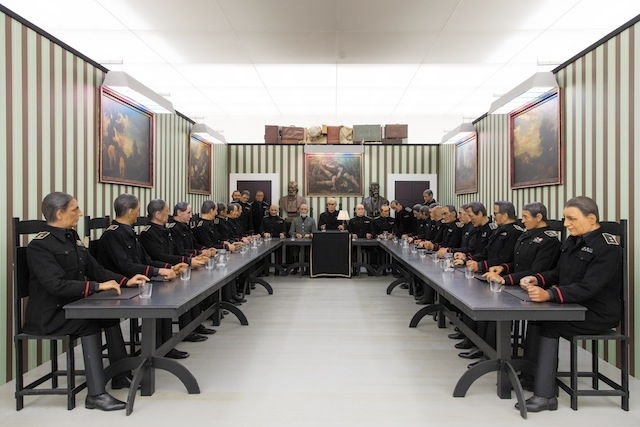Madre, Naples 26 November – 6 March
In these times of heightened political awareness and urgency, it’s often reassuring to look back at forebears who themselves confronted adverse social conditions. With this in mind, Madre presents a comprehensive retrospective of works by Fabio Mauri (1926–2009), with more than a hundred works from the 1950s to the 2000s testifying to the role of the Roman artist, a key figure in the Italian modernist avant-garde, as a critic of society’s maladies, albeit a hopeful one. The three-floor exhibition demonstrates that, as Mauri sought the most appropriate means to describe his era’s political and cultural tenor, the results were diverse.
The exhibition begins in the foyer with Ebrea (Jewess, 1971), a lifesize sculpture of a horse wearing kneepads featuring the Star of David. The work was part of an eponymous performance referencing the objectification of the Jewish people, involving a young woman, vulnerably naked, cutting locks of her own hair and arranging them on a mirror, again in the shape of the Star of David. The horse’s accessories, together with other props for the performance, were made of leather produced from the skin of murdered Jews during the Shoah. In an accompanying statement, Mauri, a non-Jew, argued that anti-Semitism was an example of a universal propensity towards racism that concerns all humans. One must, he argued, be vigilant against the potential rise of fascism, as well as against totalitarian behaviours embedded in democracy.
Moving on, and entering the Madre’s large, open ground-floor space (known as ‘Re_Publicca MADRE’), one arrives at Il Muro Occidentale o del Pianto (Western or Wailing Wall, 1993), a wall of leather and wooden suitcases whose scale impresses upon the visitor the epic human cost of migration. Passing this work, which feels very much like an object to be gotten around, the viewer encounters Sala del Gran Consiglio (Oscuramento), from 1975. The tableaulike installation, whose title translates as the Room of the Grand Council (The Obscuring), comprises three walls of a room and a U-shaped table: seated here, accompanied by an audio conversation, are 29 mannequins, representing Mussolini and 28 of his military staff, discussing how to combat the Allied invasion of Sicily. This unsettling scene conveys the tension as the Grand Council of fascism met for the last time. What Mauri brilliantly captures through his arrangement of almost-lifelike yet stilted mannequins is both the banality of evil and the extent to which we are all objects of history. The viewer feels not only subject to the whims of the assembled high-ranking officers, but that the assembled are themselves objects of historical destiny.
This exhibition continues on the mezzanine – where a number of Mauri’s films are projected – and on its third floor, where the artist’s fascination with television, film and screens per se is explored. The filmworks here are displayed in a chronological loop, beginning with Mauri’s 1950s explorations of mass media, his Schermi (Screens), which he would pursue for more than 50 years. Investigating the cinematic and televisual screen, these works varied greatly over more than 50 years, from monochromes on flat canvases to reliefs that evoke the fascia of a TV set (such as Schermo, 1970). The repeated image of the screen serves to reinforce the pervasiveness of its form in the life and consciousness of the masses in the twentieth and twenty-first centuries.
On the first floor, the Sala delle Colonne (‘room of the columns’) hosts a complete collection of the architectural models in which Mauri rehearsed his exhibition layouts. While these might be considered minor, they act as standalone works further conveying something that’s implicit throughout the show: a sense of reality always being somehow distant. The exhibition’s name (which translates as Retrospective in Solid Light) references the artist’s careerlong fascination with the notion that reality is a series of projections against which we must remain vigilant. Eight years after Mauri’s death, such a message could hardly be timelier.
From the March 2017 issue of ArtReview
